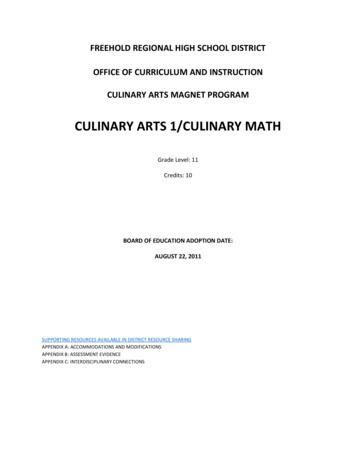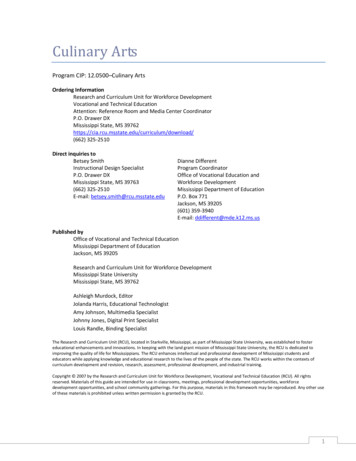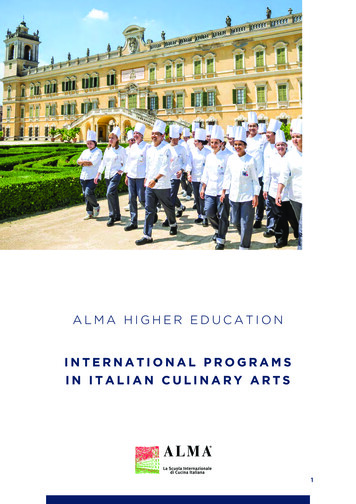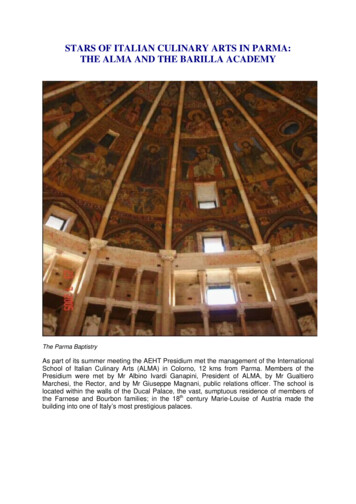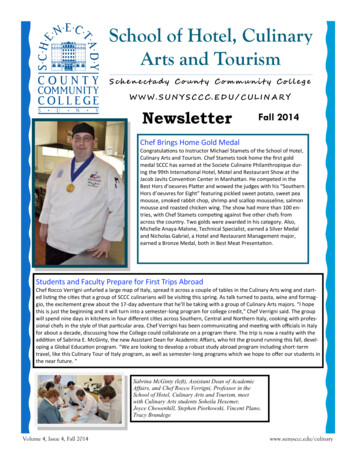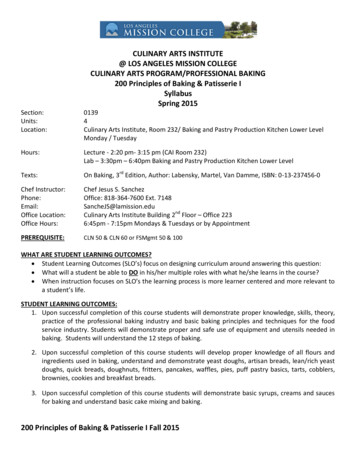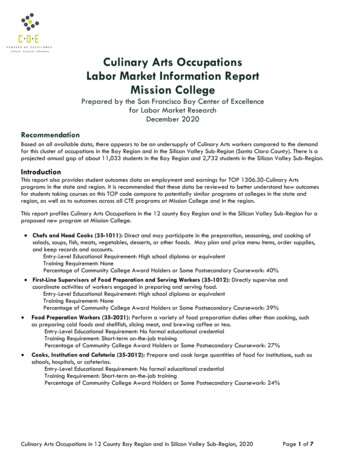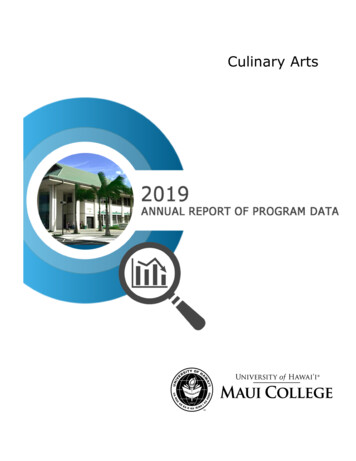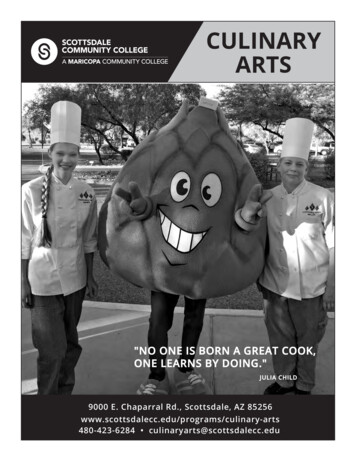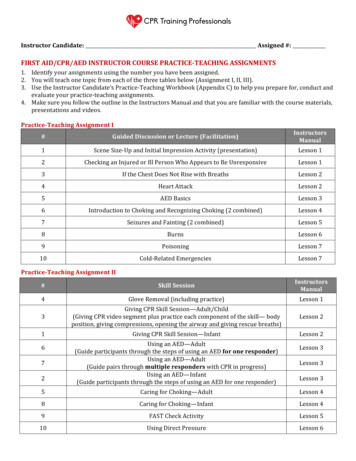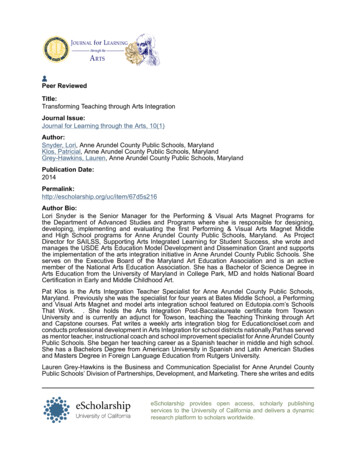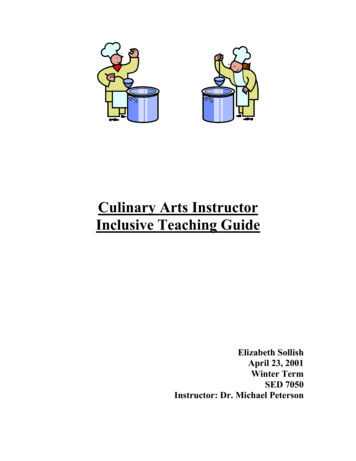
Transcription
Culinary Arts InstructorInclusive Teaching GuideElizabeth SollishApril 23, 2001Winter TermSED 7050Instructor: Dr. Michael Peterson
Culinary Arts Instructor Inclusive Teaching GuideContentsA. Introduction:Culinary EducationThe Inclusive EnvironmentB. Partnering With Parents:Parental InvolvementUse of Support System and Related ServicesCulinary Arts and the CommunityC. Collaboration:Areas of ImportanceD. Authentic, Multi-Level Instruction For Students Of DiverseAbilities:Teaching and Learning: Styles and StrategiesPractical SkillsE. Accommodations And Adaptations:Adaptations within a Lesson PlanCurriculum AdaptationsInstructional AdaptationsF. Building Community In The Classroom:Classroom CommunityStrategies for Celebrating DiversityG. Dealing With Behavioral Challenges:Classroom Management and Behavior StrategiesConflict ResolutionH. Physical Design Of The Classroom For Diverse Learners:Physical Layout of Instructional KitchenI. Accommodations For Students With Physical And SensoryChallenges:J. BibliographyK. Appendix A: Neat Forms That I Found
Introduction:
Culinary Arts Instructor Inclusive Teaching GuideIntroduction:Culinary Education; A Universal SkillCulinary Arts is skill that is universal across the world. Standard method andtechnique is the same wherever you go. There are many skills that must be acquired inorder to become a professional Culinarian, but it is these skills that can give thechallenged a chance at a true profession. A culinarian must begin with a thoroughknowledge of how to work as a professional, including a code of behavior, knowledge oftools of the trade, and the raw materials you will use in applying your skillsIt has been my dream for quite some time to act as a mentor and an educator toyouth who are in need of some special attention. It has been estimated that there areclose to one million foodservice industry jobs available, and not nearly enough skilledpeople to fill them. The food service industry offers ever-expanding opportunities. Theindustry is made up of a diverse group of people that continues to become even morediversified.The demand for quality people opens the door of experience to many who oncewould never have considered culinary arts as a profession. Industry leaders arewelcoming individuals of all levels and capacities to become a part of their team.This guide is geared toward teachers of high school students whom are taking partin a career education Culinary Arts Program, but can be easily adapted toward variousage levels and curriculums.
The Inclusive EnvironmentInclusive education defined in Teaching Special Students in General EducationClassrooms (Rena B. Lewis and Donald H. Doorlag, Prentice-Hall, 1999) means“meaningful participation of students with disabilities and other special needs in generaleducation classrooms and programs.Dr. Christopher Kliewer, who taught for four years in an inclusive elementaryschool, offers the following broad outline for an inclusive classroom: from AdaptingCurriculum and Instruction in Inclusive Classrooms: A Teacher's Desk Reference(Deschenes, C., Ebeling, D., and Sprague, J.1994.) Inclusive education is nothing more than good teaching for allstudents. Students take responsibility for their education; they help createthe structure of the classroom, including helping to establish rulesand academic program. Teachers have high expectations that all students will meet therules and academic challenges. Families are involved.
Curriculum is focused on humanity, on one another's worth. Thestudents tell their own stories or other's stories and learn aboutthings that matter in their lives. Teachers throw out the worksheets and basal reader system; theycreate curriculum that involves students.As an educator we have a very important role in our classrooms/kitchens, it is up to us toset the tone that will be the catalyst to a healthy inclusive environment. Verna Eatonoffers the following strategies in promoting an Inclusive school environment: Eaton,Verna. Inclusive Schools. Saskatchewan, Saskatchewan Valley School Division, 1996. Teacher serves as a model of how to interact with the student who has adisability:oTreat the student with the dignity and respect that all students aregivenoSpeak to the student directly, never "around" the student in his orher presenceoWhen speaking about persons with disabilities make reference tothe person first, and then the disability if it is necessary to mentionthe disabilityoDraw attention to the student's achievements and strengths Avoid congregation of students with disabilities in the class or in theschool Teach about differences as part of the regular curriculum When teaching about disabilities, speak matter-of-factly. Use the properterminology. If possible, invite experts into the classroom to speak.Parents of children with disabilities are experts. Ensure, as much as possible, that expectations and routines are the samefor all students. Where individualization is necessary, attempt to have it occur when otherstudents are receiving individualized instruction. Structure social interaction in the classroom through planned activities. Promote social interaction outside of the classroom.
Integrate everyone! The special education teacher and any support staffwho may be in the classroom should work with all students, not just thestudent with the disability. Ensure frequent communication between the school and the home. Do things with, rather than for the student when she or he needsassistance. Foster and encourage independence. Encourage peers, rather than an adult, to assist the student. Where necessary, have an affirmative behavior plan in place. Be committed to integration and inclusive practices.
Benefits of an Inclusive Classroom: Maximizes Individual Growth-Builds a Sense of CommunityChildren with Special Needs Affords a sense ofbelonging to thediverse humanfamily Provides a diversestimulatingenvironment inwhich to grow andlearn Evolves in feelingsof being a memberof a diversecommunityEnablesdevelopment offriendshipsProvidesopportunities todevelopneighborhoodfriendsGeneral Education Enhances selfrespectProvidesopportunities toexperiencediversity of societyon a small scale ina classroomDevelops anappreciation thateveryone hasunique andbeautifulcharacteristics andabilities Helps teachersappreciate thediversity of thehuman family Helps teachersrecognize that allstudents havestrengths Promotes the civilrights of allindividuals Supports the socialvalue of equality Teachessocialization andcollaborative skillsCreates anawareness of theimportance ofdirectindividualizedinstruction Buildssupportiveness andinterdependence Maximizes socialpeace Provides children aminiature model ofthe democraticprocess Developssensitivity towardothers' limitationsIncreases ways ofcreativelyaddressingchallenges Develops feelingsof empowermentand the ability tomake a differenceTeachescollaborativeproblem solvingskills Developsteamwork skills Acquires differentways of perceivingchallenges as aresult of being on amulti-disciplinaryteam Enhancesaccountabilityskills Combatsmonotony Increases abilitiesto help and teachall classmatesProvides peermodels Developsempathetic skillsProvidesopportunities to beeducated withsame-age peers Providesopportunities tovicariously puttheir feet inanother child'sshoesSociety Develops respectfor others withdiversecharacteristicsProvidesaffirmations ofindividuality TeachersEnhancesappreciation for thediversity of thehuman familyFrom "Creative Educators at Work: All Children Including Those with Disabilities CanPlay Traditional Classroom Games," by Donna Raschke, Ph.D., and Jodi Bronson, Ed.S.1999
Partnering With Parents:
PARENTS FOR INCLUSIONPartnering With Parents:Parental InvolvementParents of a challenged child will want hands-on contact with all of the planningfor their child's education. The process of inclusion can be overwhelming for parents, andthey may require assistance from other families who have experience in working withschools.You will be able to find people in the community who can help your teammembers with their tasks. There may be a parent who will volunteer to assistin the kitchen. Your school may have other volunteers who canhelp with long-range planning. If you are close to a college or university, studentswho need work experience might assist you withyour class. If your school uses a pool of students to assist inclasses, they may be able to help you with the smalljobs in your kitchen.Use of Support System and Related ServicesYou are not alone, The Book On Inclusive Education. (Tohaventa Holdings &Sutherland Productions, 1997), lists many sources of support that can be the catalyst to asuccessful inclusion experience for all involved, these are as follows:Support Network/Sources: The teacher assistant The resource teacher/resource facilitator The Principle The problem solving group Professional support
Support from own-age peers Adult support in the school and community Support from children who are challengedThe Family Parents as partners Building trust Staying in touch with parents Parent groupsFriends and Friendship Facilitating friendships Are friendships secondary to learning? Nurturing friendships Let the student shine Friendships beyond the classroom
Culinary Arts and the CommunityThe culinary arts industry is quickly becoming a respected occupation. There isan increasing demand for skilled employees. Educational facilities can be utilized toshowcase the work that is being accomplished and the progress of the students, orcommunity cooperation can be of a different nature.Many schools have entered co-operative agreements with local businesses andindustry, which enable students to learn work skills as part of the regular curriculum. Thestudent who is challenged can benefit from being included in this program along with theother students. This is a very different approach from having the student who ischallenged go to a community-based program alone while the other students are inschool.Many students have part time work after school. The student with challengingneeds may also have a part time job. Organizational skills, time and punctuality,appropriate mature behavior, personal appearance and taking responsibility becomeimportant needs.
Collaboration:
Collaboration:In order for inclusion to succeed, teachers need to combine forces with schoolstaff members and families to ensure that the needs of individual students withdisabilities are met. The best way to achieve this level of cooperation is through acollaborative team. Collaboration of the school with its surrounding community systemsis a factor to help create positive educational change. Partnerships within and outside theschool setting are essential to support education reform.Areas of Importance:Building Team StructureLearning Teamwork SkillsTaking Team ActionTeaching CollaborativelyImproving Communication And Handling ConflictAs Snell and Janney so precisely state in their book Collaborative Teaming (Paul H.Brooke), there are vital characteristics that a collaborative school/team must personify,these are as follows;§Building Team StructureSet school policy on teaming.Define team purpose and focus.Establish team membership. Create and protect time and space.Support teams and teamwork.
§Learning Teamwork SkillsListen and interact well.Develop shared values.Define team roles and responsibilities.Establish team meeting process and schedule.Prepare for conduct meetings.Give and receive information.Make decisions by consensus.Team effectively “on the fly.’Reflect on the team process.§ Taking Team ActionProblem –solve team concerns.Collaborate to design programs.Assess student progress.Review and revise team action plans.§ Teaching CollaborativelyUnderstand collaborative teaching.Plan at the school level.Understand tested organizational models and instructional strategies.Consider collaborative teaching strategies suited to grade level.Plan between collaborative teachers.Evaluate outcomes.§Improving Communication And Handling ConflictKnow and trust each other.Communicate accurately and unambiguously.Be sensitive to diverse cultures.Foster staff-family interaction.Take time to process group skills.Resolve conflicts and problems.
Authentic, Multi-Level Instruction ForStudents Of Diverse Abilities:
Authentic, Multi-Level Instruction For Students Of DiverseAbilities:Teaching and Learning: Styles and StrategiesThe individualized educational program (IEP) will serve as a way of monitoringthe student's progress and communicating results to the student, parents and staff. It willalso be an ongoing record of the student's growth.The IEP is a guide to keep you and others who work with the student on track.And it will help you link the student's high priority learning needs to the culinarycurriculum. The IEP will describe goals in three or four high priority areas (but not all ofthe student's learning for the year), as identified by the team.As you become involved in writing the IEP you will develop ownership of theprogram. No educational program will be laid upon you. You can decide, based on yourteaching style and method of organizing for instruction, what you can do in your kitchenand when you will need support.Practical SkillsThe practical skills of a culinarian (food service professional) are much differentthan that which is demanded in the regular classroom. Some of the skills remain thesame. One must be able to read in order to follow a recipe, one must be able to do mathin order to convert measurements, one must be able to problem solve in order to makeuse of critical thinking when a food product smells funny, one must have a sense ofhistory in order to establish food origin and spice combinations to compliment food ofparticular regions, and the correlations go on and on.The culinary arts demand skills that go beyond the regular classroom.Assessments will be made in the following areas. Food and Kitchen Safety Nutrition and Healthy Cooking
Equipment Identification Raw Ingredients Cooking in a Professional KitchenoMise en PlaceoSoupsoSaucesoDry-Heat Cooking MethodsoMoist-Heat Cooking TechniquesoCharcuterie and Garde-MangeroBaking and PastryoSanitation: HACCP, Storage, Temperature Danger Zones,etc Once these skills are mastered an individual can move onto a moreintense level of learning, or move out into the industry. Skills will beassessed according to the individual and the IEP that has been establishedfor the students giving capacity.The following curriculum will provide the base knowledgenecessary to pursue a successful career in the Culinary Arts, the curriculawill give you the opportunity to: Experience general education, acquire academic skills, and obtaina global perspective as related to foodservice courses. Learn and effectively practice basic and advanced technical skillsin food preparation and service. Understand the principles of food identification, food and beveragecomposition, nutrition, and dietetics. Acquire basic supervisory skills to better use human and physicalresources in foodservice operations. Gain hands-on experience in the proper use and maintenance ofprofessional foodservice equipment. Become familiar with the layout and work flow of professionalkitchens and bakeshops. Gain appreciation for the history, evolution, and internationaldiversity of the culinary arts. Develop a personal sense of professionalism necessary for workingsuccessfully in the foodservice and hospitality industry.
Study American and international cuisines, nutrition, gardemanger, business law, Culinary French, meat cutting, baking,pastry, and a whole lot more. Table service and customer relations. Work in an experimental kitchen. Take courses in menus and facilities planning, purchasing, and costcontrol.
Accommodations And Adaptations:
Accommodations And Adaptations:Adaptations within a Lesson PlanPlan Nine Types of AdaptationsSizeAdapt the number of itemsthat the learner is expected tolearn or complete.TimeAdapt the time allotted andallowed for learning, taskcompletion, or testing.For example:Reduce the number of socialstudies terms a learner mustlearn at any one times.For example:Individualize a timeline forcompleting a task; pacelearning differently(increase or decrease) forsome learners.DifficultyAdapt the skill level,problem type, or the ruleson how the learner mayapproach the work.InputAdapt the way instruction isdelivered to the learner.For example:Use different visual aids,plan more concreteexamples, provide hands-onactivities, and place studentsin cooperative groups.ParticipationAdapt the extent to which alearner is actively involvedin the task.For example:In geography, have studentshold onto the globe, whileothers point out locations.For example:Allow the use of a calculatorto figure math problem;simplify task directions;change rules toaccommodate learner needs.AlternateAdapt the goals or outcomeexpectations while using thesame materials.For example:In social studies, expect astudent to be able to locatejust the states while otherslearn to locate capitals aswell.Level of SupportIncrease the amount of personalassistance with a specific learner.For example:Assign peer buddies, teachingassistants, peer tutors, or cross-agetutors.OutputAdapt how the student can respondto instruction.For example:Instead of answering questions inwriting, allow a verbal response, usea communication book for somestudents, allow students to showknowledge with hands-on materialsSubstitute CurriculumProvide different instruction andmaterials to meet a student'sindividual goals.For example:During a language test, one studentis learning computer skills in thecomputer lab.From Adapting Curriculum and Instruction in Inclusive Classrooms: A Teacher's DeskReference, by Deschenes, C., Ebeling, D., and Sprague, J., 1994.
Curriculum AdaptationsThe Base Curriculum will be the same for everyone. This means that the studentwho is challenged will participate in the Mother sauces lesson, the knife skill class andthe butchery class, along with the other students. The student’s life experiences will beenriched, and his ability to communicate and form relationships with peers increasedthrough being included.Curriculum adjustment is about. Examining content and/or delivery processes to find alternative ways for students toachieve equivalent learning outcomes/essential competencies/academic standards;Providing a way to minimize the impact of students’ disabilities upon theirperformance without compromising course standards; andChallenging existing practices and procedures in order to develop more inclusiveways of designing and delivering curriculum.The work that the student does in the regular kitchen should be related to the workthat the other students are doing but it must be meaningful to the student. Dependent onthe students needs a culinary mentor will be available if necessary, this person will beskilled in handling a variety of disabilities.
Instructional AdaptationsGoals and objectives for the student who is challenged will be agreed upon foreach culinary instructional unit before the unit is taught. Some of the goals will relate tothe concepts and content of the culinary unit. Some will relate to the strengths and needsthat were identified by the collaborative team, and agreed upon as goals and objectives inthe IEP. The teaching of the IEP objectives will be embedded in the regular lessons androutines of the kitchen. They do not need to be taught at a separate time, in a separateplace.The indications of learning and growth may be different from those of the otherstudents in the class, but the culinary educator must recognize them as valid. If theteacher values the progress and abilities of the student who is challenged, then thechildren in the class will also value them.First, outline the skills and prep projects, which the students without disab
Culinary Arts and the Community The culinary arts industry is quickly becoming a respected occupation. There is an increasing demand for skilled employees. Educational facilities can be utilized to showcase the work that is being accomplished and the progress of the student
